Introduction
The 5 MLPs covered in this article offer yields ranging from 5.7% to 10.7%. Additionally, each of these MLPs appears reasonably valued given their high yields and prospects for growth. However, two of these MLPs are currently in the process of merging.
MLPs Simple and Complex at the Same Time
I believe that MLPs represent an investment choice that is a conundrum of sorts. In some ways, MLPs are very simple investments. They are primarily income generating vehicles that typically produce higher yields than most other investment choices. Furthermore, as a general rule, best-of-breed MLPs have a history of increasing their distributions each year. Therefore, investing in MLPs is primarily about the dividend income, or more precisely stated, the “income distributions” that they offer unit holders. On the other hand, many best-of-breed MLPs have also proven themselves to be excellent capital appreciation generators over the long term as well.
But there is also a lot of complexity associated with investing in MLPs. They have complex capital structures and many have general partner relationships that do not always favor public unit holders. Therefore, each prospective individual MLP investor should also carefully examine the partnership agreements between the general partners and limited partners. These agreements will also cover the distributable cash flow levels to include discretionary reserves mandated by the general partner.
In this same regard, there also tax considerations associated with investing in MLPs. As long as the MLP is deriving 90% or more of their income from qualifying sources, there is no tax at the entity level. Furthermore, unit holders are offered tax benefits on their distributions because a portion is considered return of capital. However, the return of capital portion also reduces the unit holder’s basis in the units.
As a result, unit holders must deal with a K-1 each year and keep track of their cost basis. This tax pass-through status is generally considered a benefit, but it also comes with additional complexity. MLPs also provide challenges to tax advantaged accounts such as IRAs because partnership income can be considered unrelated business taxable income and subject to unrelated business income tax (UBIT) if it exceeds $1000 a year. There is also estate planning tax considerations that investors must consider.
With the above said, I want to be clear to the reader that I am not an expert in investing in MLPs. However, I do believe I have something to offer that is often overlooked by investors regarding investing in MLPs. In talking with individual investors about MLPs, I have discovered that few are aware of the amount of dilution associated with investing in MLPs.
MLPs are constantly issuing more shares (units) which dilute existing unit holders, but raises much-needed capital to fund growth at the same time. For the MLPs covered in this article, this additional capital has been the source of significant revenue increases. These increased revenues allow the MLPs to continue to increase distributions in spite of the heavy dilution.
MLPs Simplified
For those readers not fully versed in MLPs, I offer the following links to the educational section of Alerian an independent provider of master limited partnership products and exchange traded funds. The first is titled MLP 101 and the second is titled MLP 201. These links will provide a basic education on MLPs. I also offer the following info graphic from the same website that simplifies MLPs and how they function
5 Fairly Valued MLPs
The following FAST Graphs’ summary lists 5 MLPs that I considered fairly valued in alphabetical order. As previously mentioned, Energy Transfer Partners, LP (ETP) and Sunoco Logistics Partners, LP (SXL) have entered into a merger agreement providing for the acquisition of ETP by SXL as a unit for unit transaction. My rationale for including these as separate entities prior to the merger is to cast a light on the complexities and challenges often associated with investing in MLPs. Limited partner unit holders are often at the mercy of controlling general partners.
In this case there is a third entity, Energy Transfer Equity (ETE) that owns the general partner and 100% of the incentive distribution rights (IDRs) of Energy Transfer Partners L.P. and Sunoco LP (SUN). This is offered simply to illustrate the complexity of investing in MLPs. Unlike investing in traditional companies, it’s important to not only analyze the specific MLP under consideration, it’s also critical to understand and analyze the general partner and all of its parts.

5 Featured MLPs: Extraordinary Historical Performance for the Income Investor
In spite of all the complexities regarding investing in MLPs I referenced above, their historical performance achievements cannot be denied. The following performance results on each of the 5 featured MLPs in this article clearly illustrate the long-term benefit of investing in MLPs. As previously stated, their primary allure is for their high level of income distributions and the growth of those distributions over time. Additionally, they have also proven themselves to be reasonable capital appreciation investments as well.
However, when examining the following performance reports, it’s important to keep the tax considerations in mind. Much of the income distribution is considered return of capital, and therefore, a major portion of MLP distributions are considered tax-deferred and the remaining portion taxed at ordinary income rates. The precise calculations are reported in each respective company’s K-1. This creates additional tax filing requirements for the individual investor.
Buckeye Partners LP (BPL)
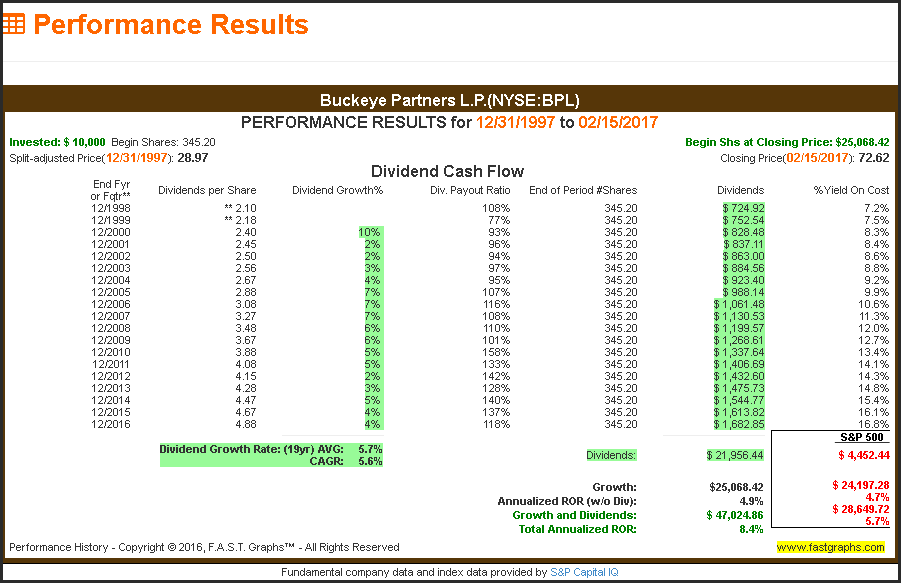
Enterprise Products Partners (EPD)
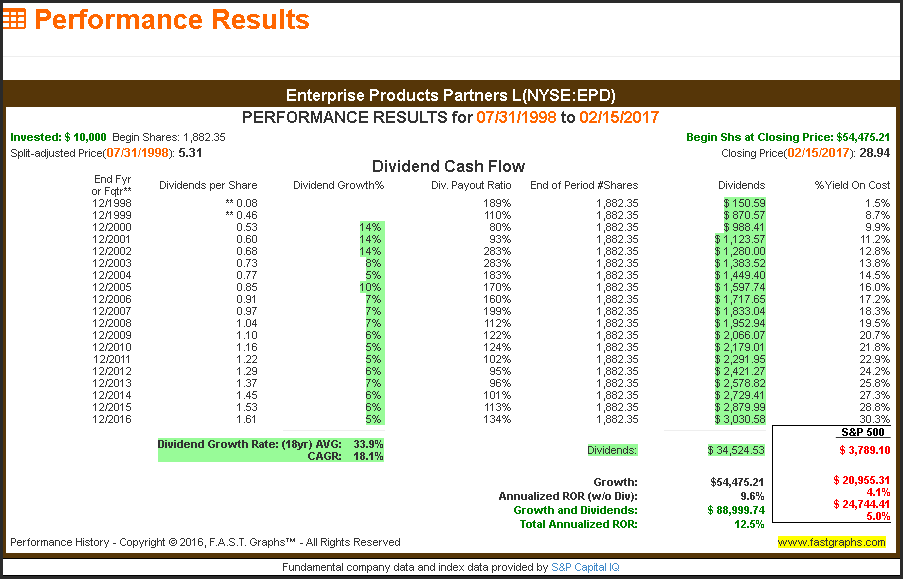
Energy Transfer Partners (ETP)
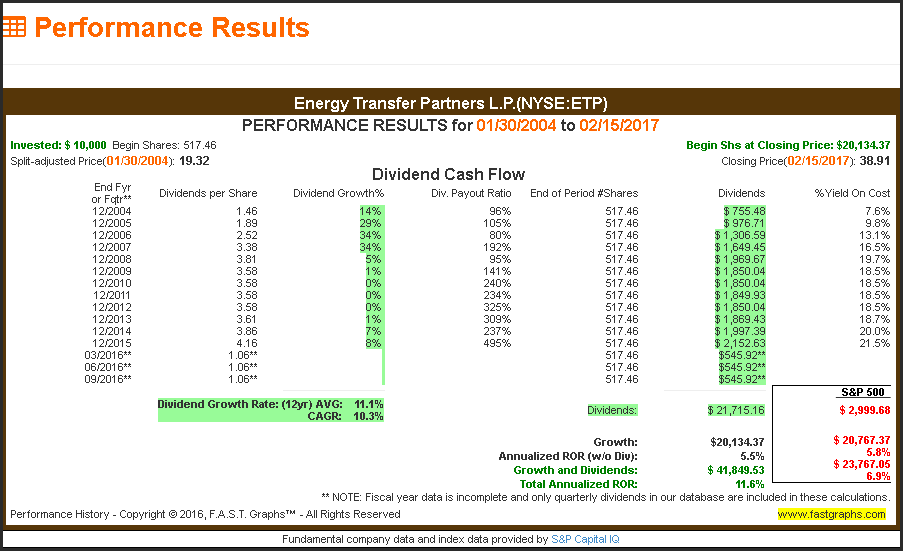
Plains All American Pipeline (PAA)
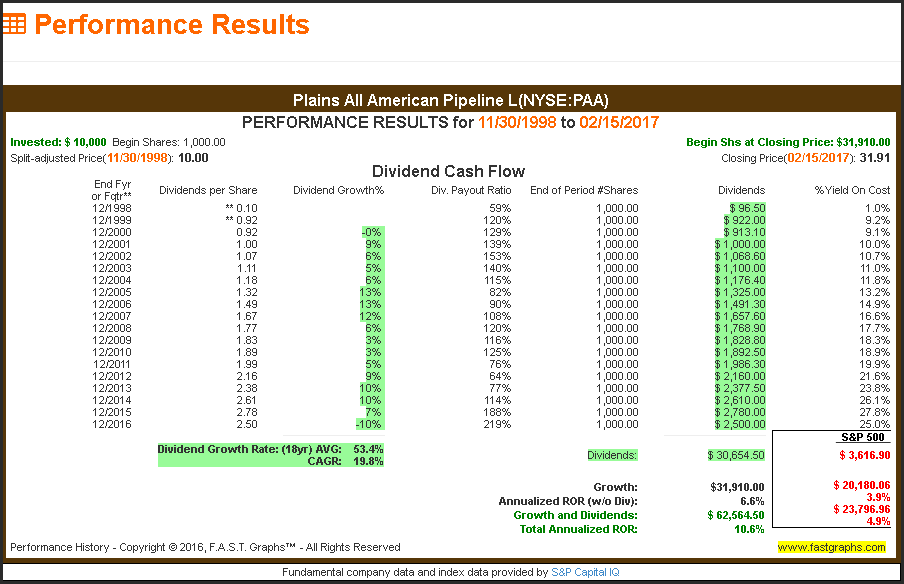
Sunoco Logistics Partners (SXL)
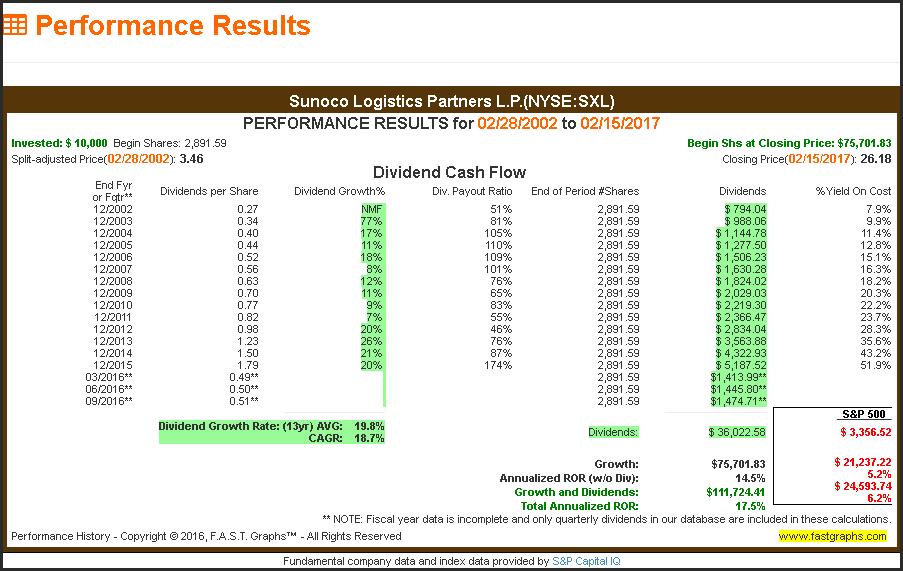
Bonus Video: Is the Dilution Worth the Yield and How Do You Value MLPs?
Summary and Conclusions
Although I featured 5 MLPs in this article, I did not go into the specific investment characteristics of each of these individual entities. Instead, my purpose was to illustrate the general potential benefits, risks and complexities associated with investing in MLPs. These are a unique asset class created by an act of Congress, and as such, I believe they require a special level of research and due diligence. There are many financial sites where specific information on each of these research candidates can be found.
Investing in MLPs can be quite rewarding over the long run when MLPs are purchased at sound valuations. However, assessing sound valuation can be challenging for the individual investor due to the complexities of their capital structures and the associated tax ramifications. In the video included with this article I’ve attempted to illustrate ways that the valuation assessments on MLPs can be simplified.
However, the challenge of understanding the financial statements of MLPs is very difficult – to say the least. Furthermore, I believe that MLP investing requires a significant amount of monitoring and constant due diligence. Consequently, in spite of their prodigious income distributions and attractive long-term capital appreciation achievements, I believe that MLPs should be considered a riskier investment class. Evidence to support that statement can be seen by looking at the credit ratings of the 5 featured MLPs in this article. Caveat emptor.
Disclosure: Long ETP
Disclaimer: The opinions in this document are for informational and educational purposes only and should not be construed as a recommendation to buy or sell the stocks mentioned or to solicit transactions or clients. Past performance of the companies discussed may not continue and the companies may not achieve the earnings growth as predicted. The information in this document is believed to be accurate, but under no circumstances should a person act upon the information contained within. We do not recommend that anyone act upon any investment information without first consulting an investment advisor as to the suitability of such investments for his specific situation.